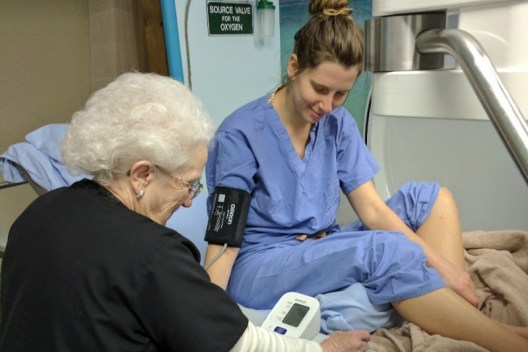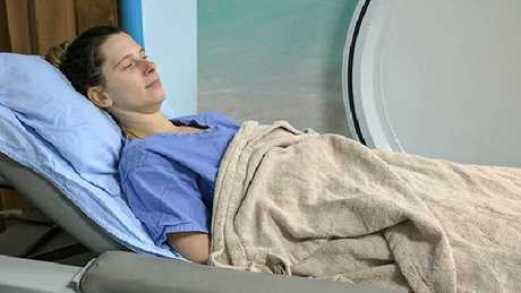It’s 4 a.m., and once again I’m unable to sleep. As I sit alone in my living room, guided meditation for pain streaming though my iPhone and sounds of my husband and dog’s snores hovering in the background, I attempt to choke back the tears.
I am on fire.
There are no flames, smoke or alarms sounding nor is there any urgency to put it out. Unlike a traditional fire, this one cannot be extinguished. Intense, unrelenting burning pain is affecting all of my limbs. They are red, warm to the touch, and grossly swollen. All I can do is wait, hoping the embers will soon dwindle to a low, more tolerable smolder.
I begin scanning the figurative toolbox in my mind. I’ve collected a fair amount of tools over the last 12 years. From medication to mindfulness, I’ve hoarded every coping mechanism I can. During the last several hours, desperate for a bit of relief and sleep, I’ve tried them all, but the fire rages on.
Complex regional pain syndrome (CRPS), also known as reflex sympathetic dystrophy (RSD) is one of the most painful disorders known to man. On the McGill University Pain Scale, CRPS/RSD ranks 42 out of 50. To put this level of pain in perspective for you, that ranks higher than both childbirth and amputation.

In addition to pain with an intense burning-like quality, many of us also experience what is called “allodynia.” This is essentially pain caused by something that wouldn’t normally cause pain. What this translates into for a CRPS/RSD patient is the inability to tolerate items such as clothing or shoes on the affected areas. Things like a sheet, blanket, or even the wind blowing a light breeze can cause extreme pain.
Deep bone pain, muscle spasms, contractures, dramatic color and temperature changes, and dystonia, are some of the other common symptoms a CRPS/RSD patient often struggles with.
Have you ever needed a root canal? Remember the pain and sensitivity? How about the continuous throbbing or basic things like talking or hot or cold causing searing pain? What about the desperation of just wanting the pain to end?
Now picture all that and then being lit on fire. Imagine the pain, sensitivity, and burning all over your entire body, every minute of the day. That is complex regional pain syndrome (CRPS/RSD).
The emotional effects of CRPS/RSD often have a profound effect too. Living in constant, excruciating pain, losing the ability to work or go to school, mobility and dexterity challenges, strained social and romantic relationships, financial obstacles, and lack of understanding and support from family and friends can all contribute to the development of anxiety or depression. Many become overwhelmed, discouraged, and feel hopeless. Dubbed the “suicide disease,” some patients desperate to halt their continuous pain, end their life. It’s one of the many tragic aspects that accompanies CRPS/RSD.
As if the physical and emotional challenges, lack of sleep and severe pain weren’t arduous enough, CRPS/RSD is classified as a rare disease, lacking proper awareness and funding not only among the public but shockingly among the medical community as well. Those medical professionals who have heard of it are often addled with an outdated understanding of diagnostic and treatment information, further complicating a patient’s prognosis.
Treatment for RSD/CRPS in many respects is still archaic and can often be just as unpleasant as living with the disease itself. Sympathetic nerve blocks, ketamine infusions, epidural infusions, IVIG, desensitization therapy, spinal cord stimulation, intrathecal pumps, and powerful medications are just some of the common therapies used to manage CRPS/RSD. None of them are prescribed with the goal of curing a patient, rather simply offering pain relief and improvement in quality of life.

When one is fortunate enough to have a competent doctor who provides a diagnosis and proper treatment plan, that is simply the first step. The patient and physician must then deal with the insurance companies, workman’s comp, or the Veteran’s Administration to get coverage. Due to CRPS/RSD’s status being a rare disease, effective therapies and medications are often denied and deemed “experimental,” leaving the patient in pain and in limbo.
Living with this disease is so incredibly painful and challenging. It’s easy to understand why some don’t feel they have the ability to continue. Every day is a struggle, new challenges always presenting around the corner. Our community desperately needs help. We need recognition, funds, awareness, and respect from both the public and medical communities.
As the sun rises this morning and I prepare myself to face the day with no sleep and high pain levels, I cling to that sliver of hope I hold in my heart. I hope one day the narrative can change and with better treatment, lives will improve and be saved allowing CRPS/RSD to shed it’s heartbreaking nickname.

Written:By


